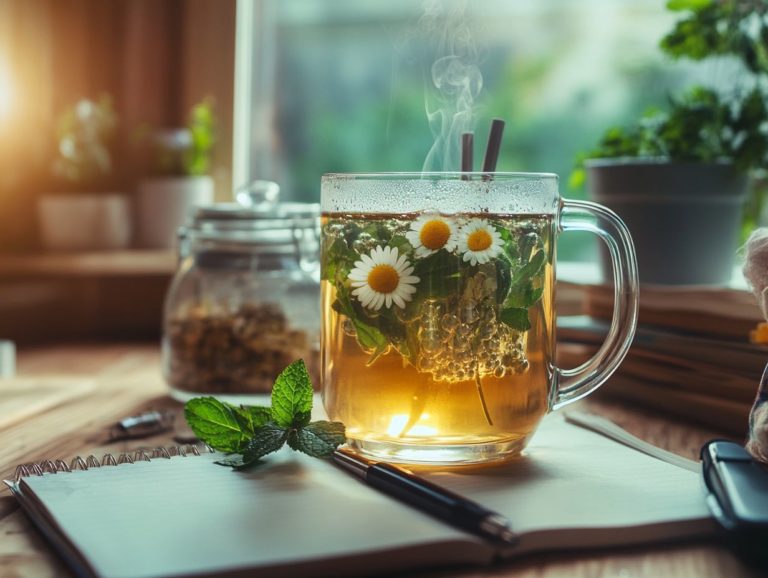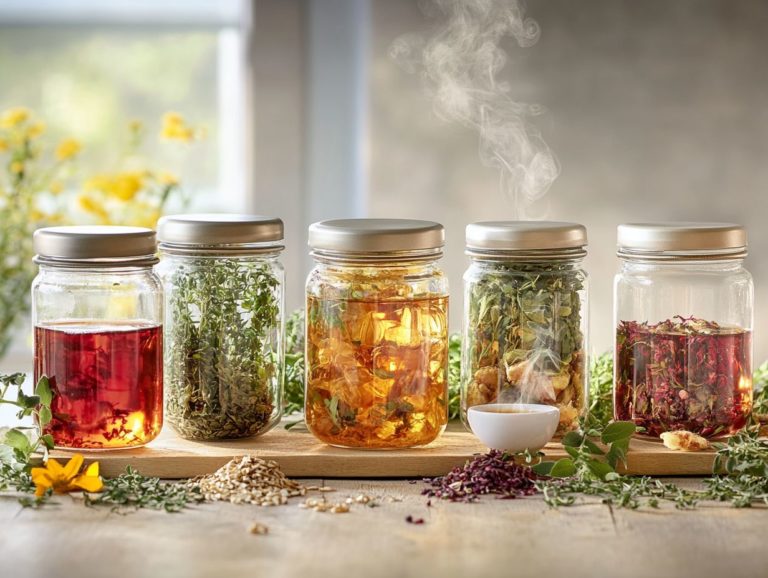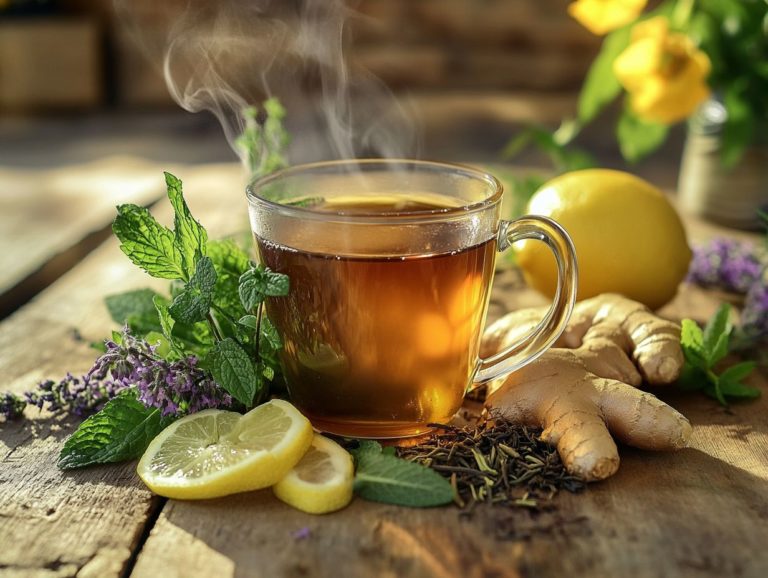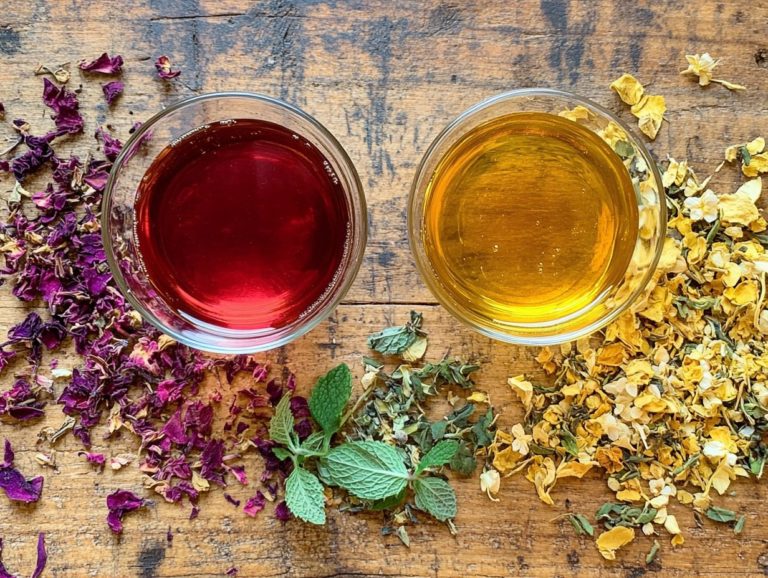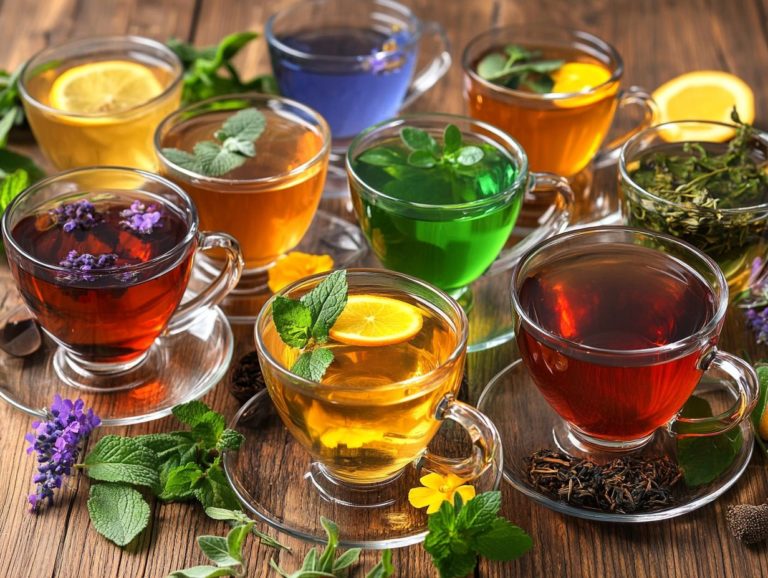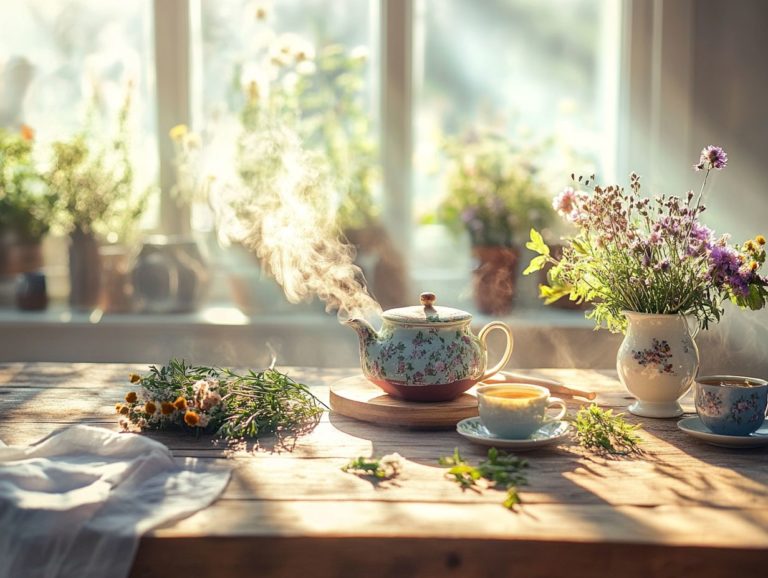Understanding Herbal Tea: Types and Benefits
Herbal tea is a beloved beverage for many, offering a delightful alternative to traditional teas like lemongrass and rooibos.
What sets herbal tea apart? This article explores the exciting world of herbal infusions, revealing types like chamomile, hibiscus, and ginger, along with the incredible health benefits they bring.
You ll find step-by-step guidance on brewing the perfect cup and tips for selecting the ideal herbal blend tailored to your needs.
Get ready for a soothing and flavorful journey into the world of herbal tea, where you can discover the benefits of various blends, including butterfly pea flower tea and cota tea!
Contents
- Key Takeaways:
- What is Herbal Tea?
- Types of Herbal Tea
- Health Benefits of Herbal Tea
- How to Prepare Herbal Tea
- Choosing the Right Herbal Tea for You
- Frequently Asked Questions
- What is herbal tea, and how does it differ from regular tea?
- What are the different types of herbal tea?
- What are the benefits of drinking herbal tea?
- Can herbal tea be used to treat specific health conditions?
- Is herbal tea safe for everyone to drink?
- How should herbal tea be brewed for the best flavor and benefits?
Key Takeaways:
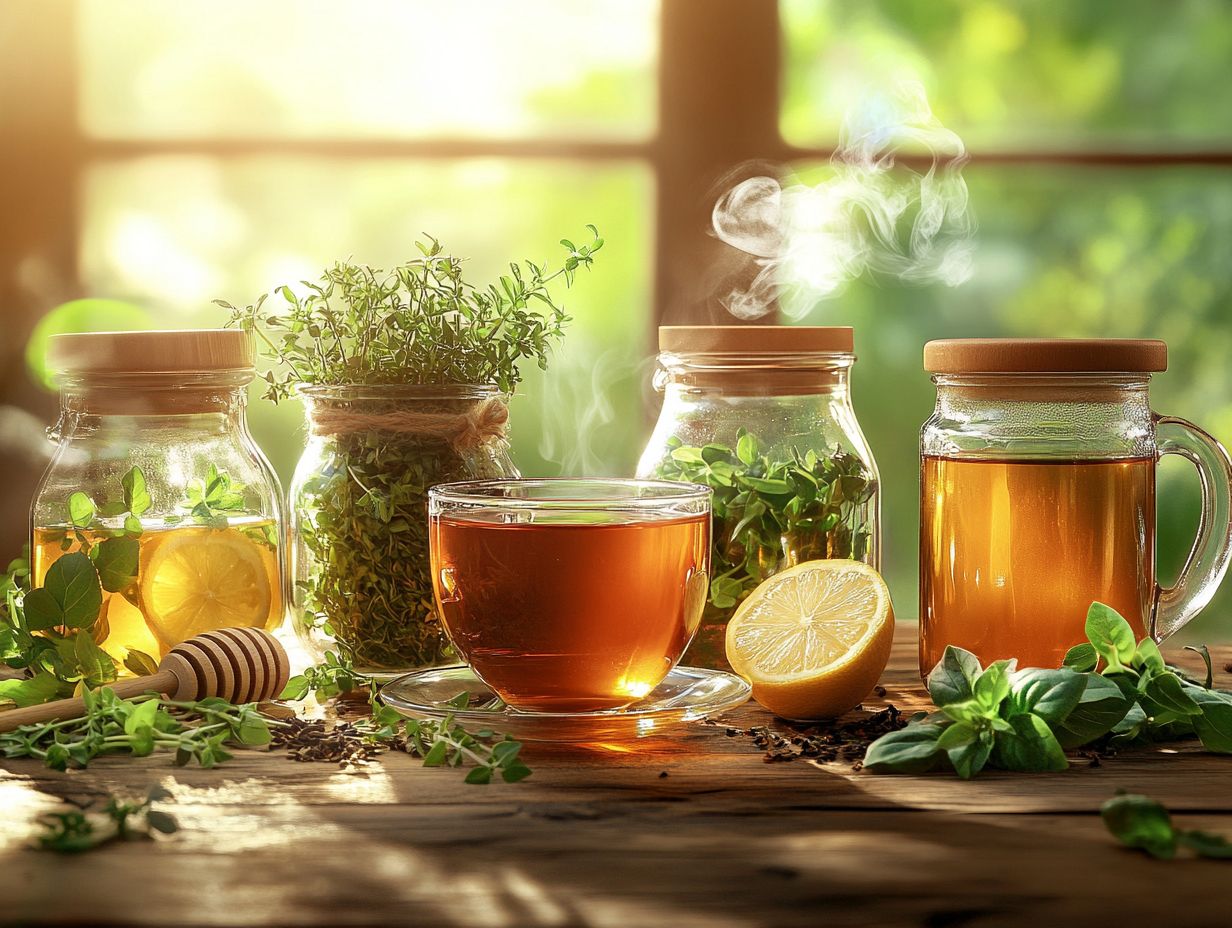
What is Herbal Tea?
Herbal tea is a delightful infusion made from a mix of herbs, flowers, and spices, presenting an exquisite array of flavors and health benefits. Unlike traditional teas made from the Camellia sinensis plant, herbal teas are naturally caffeine-free, allowing you to enjoy them at any time of day without worry.
As you delve into the enchanting world of herbal teas, you’ll uncover diverse types and remarkable health benefits. Preparation methods showcase their unique qualities.
From chamomile to hibiscus, butterfly pea flower tea, and even rooibos tea, each variety tells a story of its origins, drawing from rich traditions in regions like South Africa, India, and Southeast Asia.
Differentiating Herbal Tea from Traditional Tea
Herbal tea distinguishes itself from traditional tea primarily through its caffeine-free nature and an eclectic mix of ingredients. Instead of relying solely on the leaves of the Camellia sinensis plant, herbal tea is crafted from a delightful blend of herbs, flowers, and spices, including herbal remedies that support wellness.
In contrast, traditional teas like black, green, and oolong come specifically from the Camellia sinensis, each presenting a unique flavor profile shaped by distinct processing methods. Preparing herbal teas involves infusing dried components in boiling water, drawing out rich aromas and beneficial compounds. For those interested in exploring this further, herbal tea: a natural approach to wellness offers great insights. Traditional teas, however, often undergo techniques such as oxidation or fermentation. Herbal teas remain caffeine-free, providing a soothing alternative.
Both categories offer unique health benefits. Herbal teas are known for enhancing the immune system and providing a wealth of antioxidants. For example, herbal teas like chamomile and peppermint are celebrated for their calming effects, while traditional varieties are renowned for their antioxidant properties and potential to boost metabolism. Additionally, discovering the benefits of green tea and how to brew it can enhance your tea experience. Exploring both types allows you to enjoy a rich experience that caters to your preferences and health needs.
Types of Herbal Tea
The world of herbal tea is as diverse as it is delightful, offering a rich tapestry of flavors and benefits from various plants. Each provides its own unique aromatic experience and health advantages.
You can indulge in calming chamomile tea or invigorate your senses with peppermint tea. Perhaps you prefer the zesty kick of ginger tea, the soothing essence of lavender tea, or the refreshing qualities of lemongrass tea. Each type caters to your preferences and health needs.
Herbal teas such as hibiscus, butterfly pea flower, and rooibos not only tantalize your taste buds but also provide a wealth of antioxidants and polyphenols.
Common Ingredients and Varieties
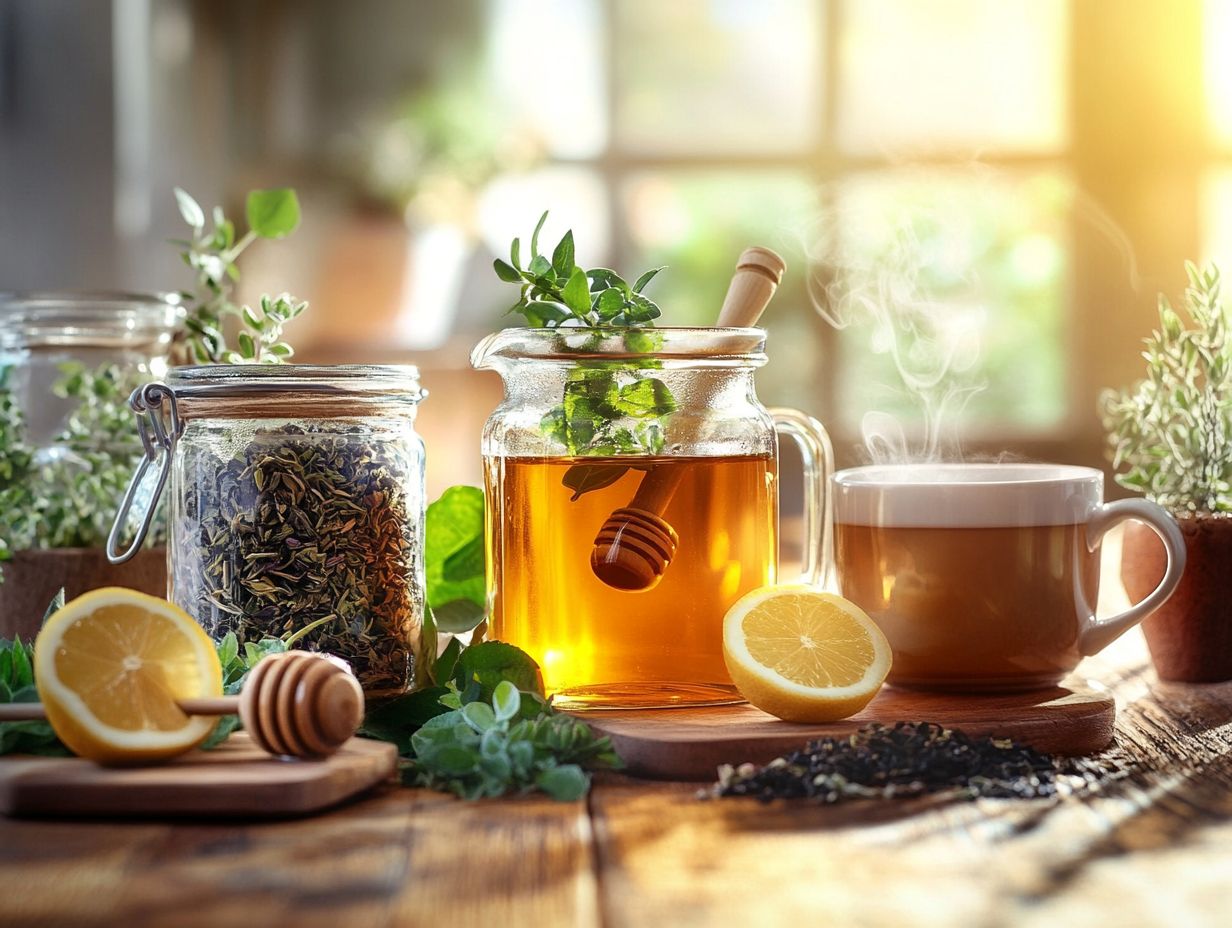
Common ingredients in herbal teas include vibrant herbs and botanicals like chamomile, peppermint, ginger, lavender, hibiscus, and butterfly pea flower. Each of these elements contributes its own unique flavor and health benefits to your brew.
These ingredients not only excite your taste buds, but they also carry a rich tapestry of historical and cultural significance. Chamomile offers a calming effect and is often sought in traditional remedies to ease anxiety and promote restful sleep.
In contrast, peppermint refreshes your palate while aiding digestion and providing numerous peppermint benefits. Ginger is known for its warming properties and its centuries-old use in various cultures to combat nausea and inflammation.
Lavender adds an aromatic floral touch, celebrated for its relaxing qualities. Hibiscus brings a delightful tartness and vibrant color, full of potential to lower blood pressure and offers many hibiscus benefits. Lastly, butterfly pea flower unveils a mesmerizing blue hue, recognized for its antioxidant properties and traditional role in Southeast Asian wellness practices. To enhance your tea experience, refer to herbal teas: how to choose the right one.
Health Benefits of Herbal Tea
Herbal tea is a delightful treat packed with amazing health benefits that can elevate your well-being and support various bodily functions.
Each type of herbal tea comes with its own unique advantages:
- Chamomile tea invites relaxation,
- Peppermint tea aids digestion,
- Ginger tea combats inflammation,
- Lavender tea helps melt away stress, and
- Hibiscus tea is full of antioxidants that can help your immune system.
This impressive variety of benefits makes herbal tea a critical ally in any health-conscious lifestyle, especially when considering the antioxidants and flavonoids present in many blends. To learn more about how these teas can contribute to your health, explore the science behind herbal tea benefits.
Potential Health Improvements
Regularly enjoying herbal tea, including chamomile, peppermint, and ginger tea, can lead to remarkable health improvements such as enhanced immunity and better digestion.
This is all thanks to the rich collection of antioxidants and natural compounds that can help protect your body. Chamomile tea is linked to significant reductions in anxiety, backed by various studies that underscore its soothing effects.
Lavender tea is also recognized for its calming properties, making it one of the 5 herbal teas for relaxation and calm. Peppermint tea has garnered attention for its digestive benefits, often providing relief from discomfort and bloating after meals.
Green tea frequently appears in scientific literature for its potential cardiovascular advantages, primarily due to its high concentration of catechins. Even simple herbal blends like rooibos, cota, and lemongrass are acknowledged for their anti-inflammatory properties, making herbal tea for skin nourishment a valuable addition to your daily routine.
How to Prepare Herbal Tea
Preparing herbal tea is a delightful process that invites you to unlock the full flavors and health benefits of your chosen herbs, including the unique qualities of cota and lemongrass.
Start by selecting an herbal tea blend that speaks to you. Simply add it to hot water and let it steep for the appropriate duration, which varies with each herb.
This method ensures that you savor every aromatic note and benefit, whether you’re indulging in soothing chamomile or revitalizing peppermint infusion. Each cup becomes a moment of enjoyment and well-being.
So why not brew a cup today and enjoy the incredible benefits?
Step-by-Step Instructions
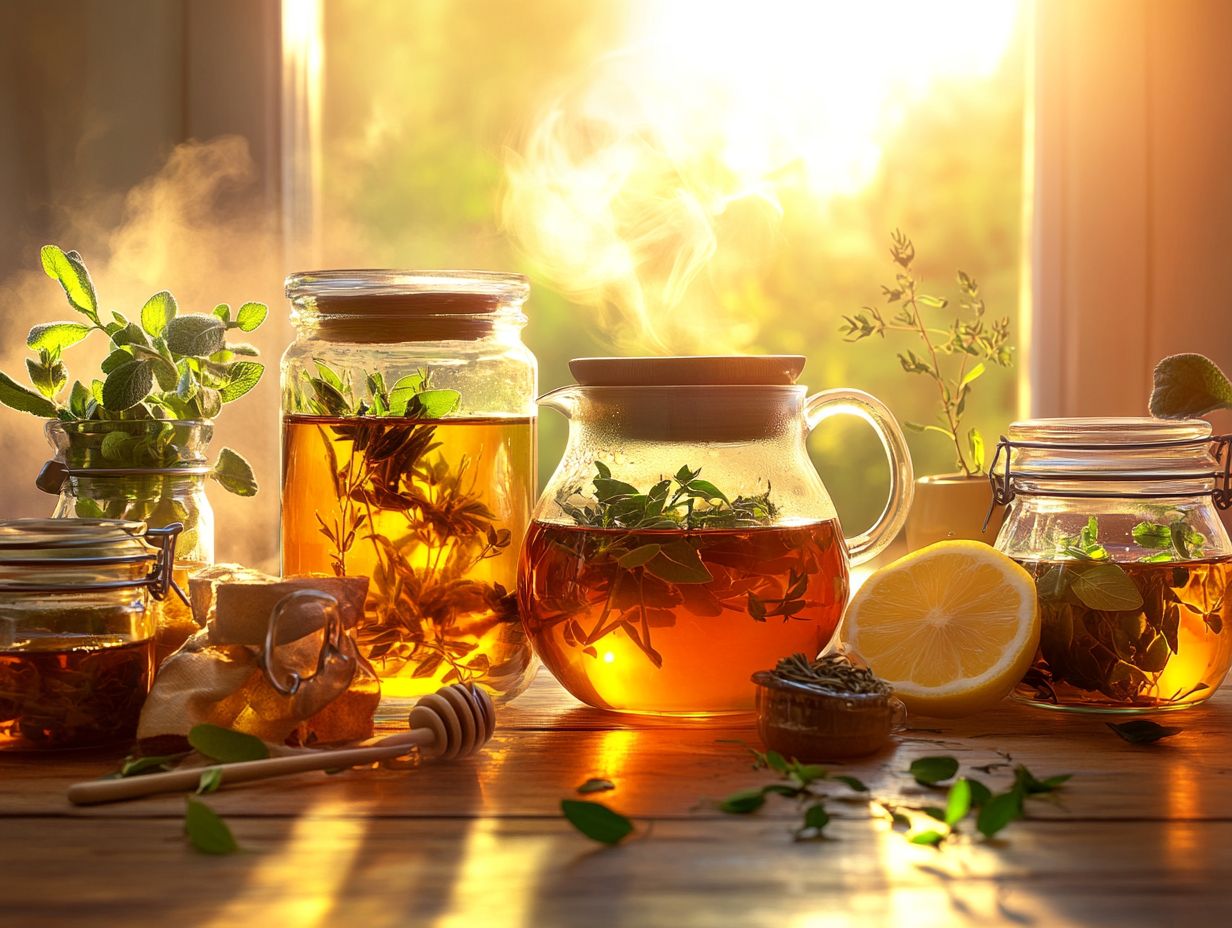
To prepare herbal tea, begin by boiling fresh water, ensuring it reaches the right temperature for optimal flavor extraction.
Next, measure out your desired amount of herbs or tea bags and place them into a teapot or cup. This allows for a soothing infusion!
It’s crucial to use water at the right temperature typically around 200 F for most herbal varieties. This ensures the extraction of vital antioxidants and flavors.
Once the water reaches this optimal temperature, pour it over the herbs and let them steep for about 5 to 15 minutes, depending on your preferred strength. After steeping, be sure to remove the herbs or tea bags to avoid any bitterness.
In terms of serving, consider adding a splash of honey or a slice of lemon to elevate the taste. You can enjoy this herbal delight hot or cool it for a refreshing iced treat!
Choosing the Right Herbal Tea for You
Choosing the right herbal tea can significantly enhance your enjoyment and health. Reflect on elements such as different tastes, the health benefits you desire, and any particular herbal properties that resonate with your lifestyle.
If relaxation is what you seek, chamomile tea could be your perfect companion. Conversely, if you re in need of digestive support, you might find peppermint or ginger tea to be more suitable.
Factors to Consider
When selecting herbal tea, take a moment to reflect on your personal flavor preferences and any specific health needs you may have.
Consider whether you desire caffeine-free options, especially those that highlight the benefits of chamomile and rooibos. It’s important to explore a diverse array of blends, as each herbal tea presents its own unique taste and aroma!
From the invigorating notes of peppermint to the comforting embrace of chamomile, options including ginger and lavender tea offer added variety. Your lifestyle choices, such as whether you’re in search of an energizing morning ritual or a soothing evening cup, can also play a significant role in your selection.
Ultimately, the pleasure of discovering herbal teas lies in harmonizing these elements to find the perfect match that delights your palate and nurtures your well-being. To enhance your experience, consider learning about herbal infusions: methods and benefits. Explore different herbal teas and find your favorite today!
Frequently Asked Questions
What is herbal tea, and how does it differ from regular tea?
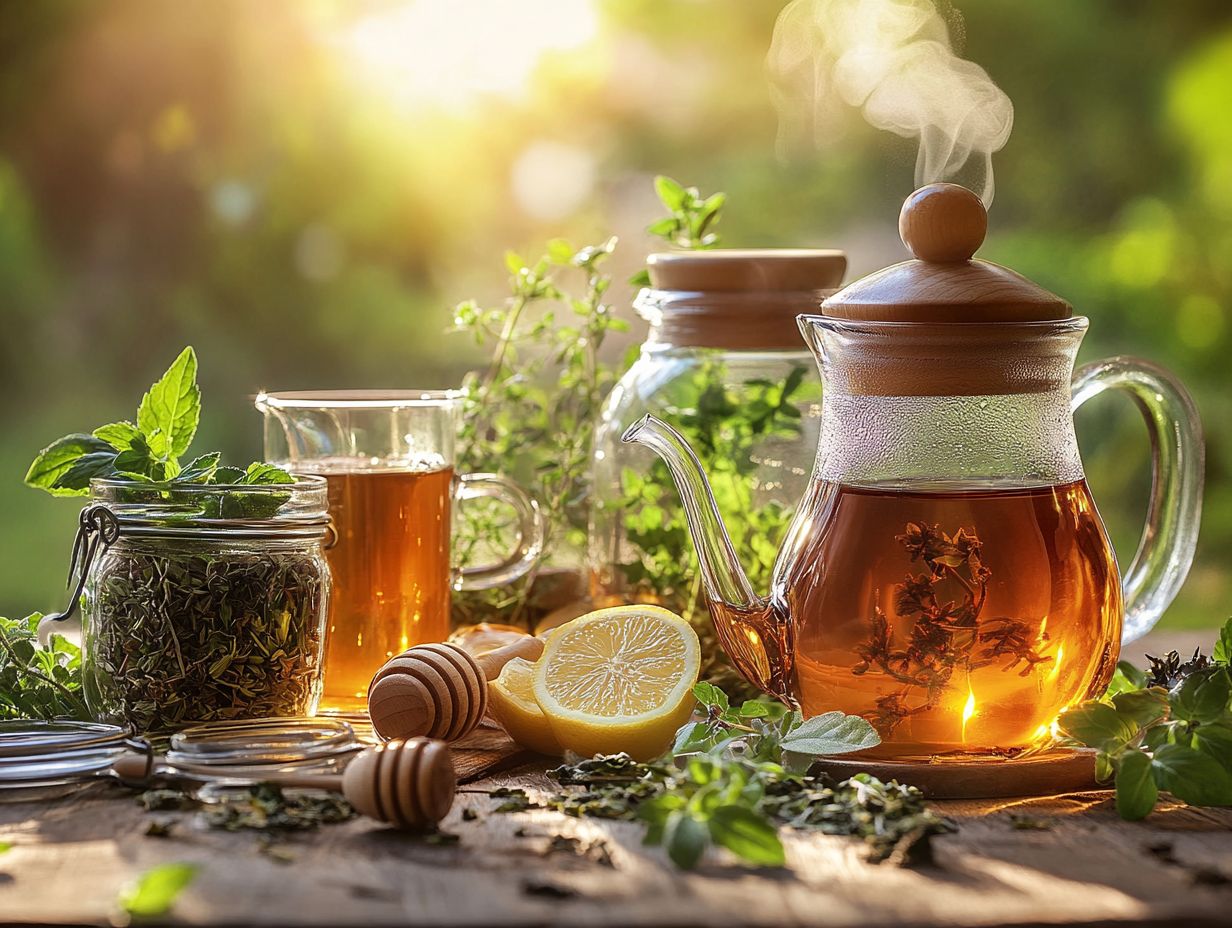
Herbal tea, also known as herbal infusion, is a beverage made from steeping various herbs, spices, fruits, or flowers in hot water. Unlike regular tea, it does not contain any tea leaves from the Camellia sinensis plant, which is used to make black, green, and white teas.
What are the different types of herbal tea?
There are countless types of herbal tea, each with its own unique flavor and potential health benefits. Some popular types include chamomile, peppermint, ginger, hibiscus, rooibos, and even blends inspired by regions like South Africa and Southeast Asia.
Other types may also include ingredients such as lavender, lemongrass, and turmeric.
What are the benefits of drinking herbal tea?
The benefits of drinking herbal tea can vary depending on the type of herbs used. Some common benefits include improved digestion, reduced inflammation, boosted immune system, and improved sleep.
However, it’s always important to do your research and consult with a healthcare professional before consuming herbal tea for medicinal purposes.
Can herbal tea be used to treat specific health conditions?
Herbal tea boasts a variety of exciting health benefits! It’s not a cure, but it can help soothe some symptoms.
Some herbs, especially those from India and Europe, have been traditionally used for relief. Always check with your doctor before diving into herbal remedies!
Is herbal tea safe for everyone to drink?
In general, herbal tea is safe for most people. However, some herbs may interact with medications or affect certain health conditions.
For instance, individuals with sensitivities should be cautious with herbs from the Western Cape. Pregnant women, children, and those with specific health issues should consult a healthcare professional before enjoying herbal tea.
How should herbal tea be brewed for the best flavor and benefits?
For the best flavor, steep herbal tea in hot water for 5-10 minutes, based on the herbs used. Always use fresh, filtered water and cover the tea while steeping to trap the essential oils.
To maximize flavor and benefits, avoid adding milk or sweeteners, especially with unique blends from New Mexico or Asia.

